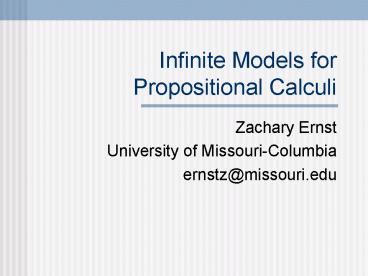Infinite Models for Propositional Calculi - PowerPoint PPT Presentation
Title:
Infinite Models for Propositional Calculi
Description:
Infinite Models for Propositional Calculi Zachary Ernst University of Missouri-Columbia ernstz_at_missouri.edu The Gist Finite matrix models are equivalent to finite ... – PowerPoint PPT presentation
Number of Views:50
Avg rating:3.0/5.0
Title: Infinite Models for Propositional Calculi
1
Infinite Models for Propositional Calculi
- Zachary Ernst
- University of Missouri-Columbia
- ernstz_at_missouri.edu
2
The Gist
- Finite matrix models are equivalent to finite
state bottom-up tree automata. - So perhaps, more powerful automata can play the
role of infinite matrix models.
3
The Problem
- Finite matrix models are good for showing that
formulae are not theorems of propositional
logics. - But many systems require infinite models.
- These are hard to enumerate, and there is no
good, flexible framework for describing them.
4
Another Example
- System due to J. Anderson
- Cxx
- CCIxxy (where IxCxx)
- CCIxyxCCIIxyz
- Modus Ponens and Universal Substitution
- Theorems are all of the form
- CCIIIIxxy, for any number of Is.
5
A Hyperfinite System
- Andersons system is hyperfinite
- Any finite model that respects modus ponens and
uniform substitution validates every formula. - This is easy to show, and the proof is
informative about the limits of finite models.
6
The Proof
Consider the following infinite sequence of
theorems
Ix IIx IIIx IIIIIIx IIIIx
7
The Proof
If M is some arbitrary finite matrix model
Ix IIx IIIx IIIIIIx IIIIx
then there must be some pair of formulae in the
sequence that M identifies.
8
The Proof
Ix IIx IIIx IIIIIIx IIIIx
Suppose M thinks that IIx IIIIIIx.
9
The Proof
Ix IIx IIIx IIIIIIx IIIIx
Suppose M thinks that IIx IIIIIIx.
Then according to M CIIIIIIxIIx Cxx, which is
a theorem.
10
The Proof
According to M CIIIIIIxIIx Cxx, which is a
theorem.
Now consider CCIIIIIIxIIxyCCIIII(IIx)(IIx)y,
which is of the form CCIIIIXXY, which is a
theorem (where XIIx).
11
The Proof
According to M CIIIIIIxIIx Cxx, which is a
theorem.
Now consider CCIIIIIIxIIxyCCIIII(IIx)(IIx)y,
which is of the form CCIIIIXXY, which is a
theorem (where XIIx).
So one application of modus ponens yields
y. Therefore, the model must validate everything.
12
What Happened?
- Finite matrix models must identify two elements
of any sufficiently long list of formulae. - So it will incorrectly think that when those
formulae are combined, the resulting formula will
be equivalent to Cxx. - No finite matrix model validates exactly the
instances of Cxx (Gödel). - If Cxx is a theorem, then the model will validate
the formula.
13
How to Use a Matrix Model
1
2
CpCqq
1 2
1 1
1
2
p
q
q
14
How to Use a Matrix Model
1
2
CpCqq
1
1 2
1 1
1
1
2
p
1
q
q
2
2
15
Finite Matrices as Finite Automata
CpCqq
- Using a finite matrix model is like letting an
automaton run over a tree. - Designated Values are like Accept States.
1
1
p
1
q
q
2
2
16
The Disanalogy -- Vocabulary
- Finite tree automata have a finite input
language. - Logics have an infinite language with countably
many variables. - This matters for models, but not for
countermodels.
17
Restricting the Input Vocabulary
- Suppose Cpq, r?s, by condensed detachment, and
suppose s has fewer distinct variables than one
of the premises. - Then there is a substitution ? such that
- ?p ?r ?qs, and
- ?Cpq and ?r have no variables not appearing in s.
- Therefore, if P is a set of premises, and there
is a proof of C from P, then there is a proof of
C from P containing only variables occurring in
C.
18
Restricting the Input Vocabulary
- So we know in advance how many variables are
necessary for a proof of C from P, if such a
proof exists. - Thus, we do not need a countermodel containing
infinitely many variables if C has a single
variable, then the countermodel is only required
have an interpretation for only one variable. - So it does not matter that tree automata have a
finite input language they still might serve as
countermodels.
19
A Stronger Automaton
- Weighted Tree Automata use weights from a
semiring - Suppose semiring is
- Every transition has a transition cost from
- The costs for each successful run are multiplied
using the semiring multiplication. - The total costs for all runs are added using the
semiring addition. - The automaton accepts a tree if the cost
associated with the tree is in some subset
20
Are Weighted Automata Strong Enough for Infinite
Models?
- For some infinite sequence of formulae, a
weighted automaton must be able to assign a
different weight to each member of the sequence. - It is easy to construct an automaton that
calculates the binary value of a tree. In other
words, there is an automaton such that
21
Weighted Automata and Reflexivity
- Recall that Gödel showed that no finite model
accepts exactly the instances of Cxx. - But if the binary value of then there
is an automaton such that
Terminology We say that A 0-accepts only the
instances of Cxx.
22
Weighted Automata and Andersons Hyperfinite
System
- Recall that the theorems of Andersons system are
- We can construct an automaton such that
- So let
23
YQE
- Show that CCxyCCxzCyz does not imply CxCyCxy,
with the rule modus ponens and uniform
substitution. - Ted Ulrich has shown that if YQE does not imply
CxCyCxy, then it will take an infinite model to
show this.































